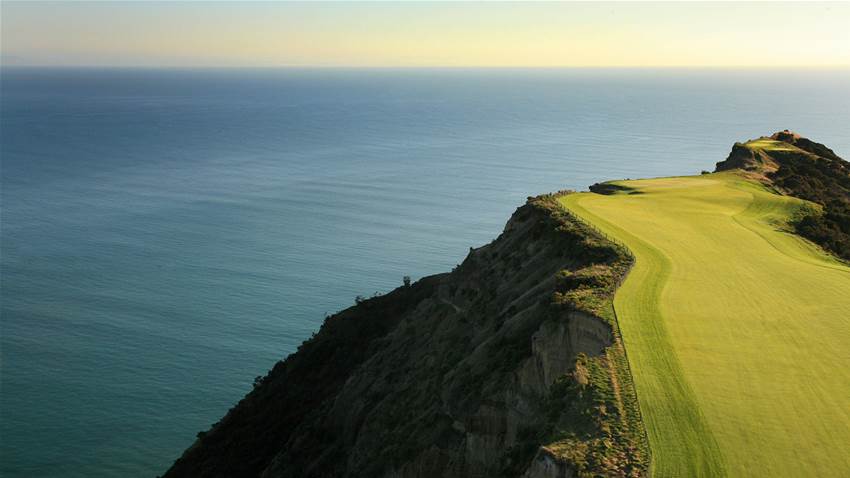New Zealand’s North Island is one of the most scenic destinations on the planet. And its rolling hills and clifftops have become home to some world-class golf courses.
Royal Wellington Golf Club is less than a 30-minute drive from the CBD – where restaurants, cafés and the Wellington Cable Car await. The Rydges Hotel is close to it all, and provides comfortable and affordable rooms.
Another fascinating place to visit on the North Island is Lake Taupo. This freshwater lake has a surface area of more than 600 square kilometres, making it approximately the same size as Singapore. From observing the geothermal activity at the ‘Craters of the Moon’ to a jet-boat ride at the base of the Huka Falls, there is plenty to keep you occupied. Oh, and there are a number of good golf courses, too.
 Two of the very best are Wairakei Golf & Sanctuary and The Kinloch Golf Club. Kinloch is the only Jack Nicklaus Signature golf course in New Zealand – and is often mentioned in the same breath as Kauri Cliffs, Cape Kidnappers and Tara Iti as one of the North Island’s premier courses.
Two of the very best are Wairakei Golf & Sanctuary and The Kinloch Golf Club. Kinloch is the only Jack Nicklaus Signature golf course in New Zealand – and is often mentioned in the same breath as Kauri Cliffs, Cape Kidnappers and Tara Iti as one of the North Island’s premier courses.
The Lodge at Kinloch opened in 2016 – nine years after the completion of the course – to allow visitors the option of staying in luxury on-course accommodation. The reception area and restaurant is perched atop a hill, and boasts 180-degree views of the property and lake.
Many observers tend to agree that Nicklaus-designed tracks are too difficult for the average punter. But Kinloch bucks that trend, for the most part, with its fair and occasionally ‘gettable’ layout. The exception to that rule, however, is the number of blind tee shots which, for the traveling golfer, will most probably result in some unnecessary punishment.

My playing group unanimously agreed that the closing trio of holes was the highlight of the day. But the par-4 6th is what generated the most conversation.
The tee points directly towards the green – but the playing surface lies 45 degrees to the right. It is simple to see the correct playing line. Club selection, however, becomes a huge challenge. And anyone game enough to attack the green with their drive will need to clear the better part of 300 metres to avoid the unforgiving wasteland.
Thankfully, the drive to our next destination was much less daunting. I’m not sure I’ve ever set foot on a golf course as enchanting as Wairakei. From the Ponga-fern bunker faces to the Tui-bird tee markers, the Peter Thomson and Mike Wolveridge-designed layout is completely charming.

The native flora and fauna abound and – like a lot of properties in the area – features a working predator fence. There is also an on-site biologist to watch over the Takahe birds, which were once thought to be extinct and are rarer than the Kiwi bird.
Wairakei’s bentgrass greens may not be as exciting or as dramatic as others, but they are absolutely immaculate and a joy to putt on. The routing of the course is also superb, as it sends you in all directions of the compass.

Wairakei was built in the early 1970s by the government – and in many ways it represents the start of the movement to bring golf tourism to the country. Fast-forward nearly 50 years, and the North Island of New Zealand has become one of the finest destinations for golf in the world. It is also less than a three-hour flight from the east coast of Australia ... So yeah, I guess that’s why I’m still smiling.
ADD THESE GEMS TO YOUR ITINERARY
MURIWAI GOLF CLUB
In the great tradition of the world’s finest links courses that are found in Scotland and Ireland, Muriwai Links is, at first, not much to look at.
Having turned off the main road leading into the seaside town of Muriwai Beach, the links first comes into view as you slowly make your way towards the club’s front gate. Wedged between forest covered hills to the east and the high sand dunes behind the beach to the west, Muriwai ticks all the boxes to be considered a wonderful links layout.
Although it is only about 45 minutes’ drive west of the Auckland CBD, Muriwai gives the impression of being isolated and the only reason why it is here is the quality of the golfing land it covers. The addition of an extensive irrigation system in recent years has elevated the quality of presentation here and the fairways are some of the best to be found in the region.

Muriwai is a certainly a course of two contrasting nines. The outward half is sparse, with wide fairways framed by long, wispy wild grasses. Most of the holes on this nine really rely on the wind to defend par, which is never a problem as calm, windless days are rare here.
If you make a good score on the front nine, you will have to try and hang on to that throughout the more challenging and undulating back nine where outcrops of ti-tree and long stands of pine trees narrow the fairways and swallow mis-hit shots. Laid over and between sand dunes, the inward half is Muriwai at its best with pot bunkers dotting the landscape, mounds and hollows around greens and rippled fairways presenting a variety of lies for approach shots.
TITIRANGI GOLF CLUB
The 1920s was a golden age for golf course design and construction in Australia thanks, in no small part, to the creativity and genius of legendary designer Dr Alister MacKenzie.
His 1926 trip to Australia, to primarily design Royal Melbourne’s West course, ended with him designing or consulting on several more course projects including Kingston Heath, Royal Adelaide and New South Wales – all of which remain ranked among Australia’s best courses.
New Zealand also benefited from MacKenzie’s visit Down Under. Having learned the “Good Doctor” was in Australia, the directors of Auckland’s Titirangi Golf Club arranged for MacKenzie to stop over on his return voyage to the United States.

MacKenzie was confronted with a layout spread across a sometimes dramatically undulating landscape with several natural water hazards and pockets of native trees and shrubs. He stayed in Auckland for a month and oversaw the initial redesign work.
However, by the mid-90s the course had become rundown and overgrown in many parts. English-born course designer Chris Pitman, a 30-year devotee and student of MacKenzie’s work, was then commissioned by the club to return the layout to its former glory. Pitman did not change the routing, nor did he change any green sites. His major changes came in the form of modifying greens and bunkers as well as the removal of overgrown, and old, Pine trees that had encroached onto playing lines on many holes.
Using MacKenzie’s original sketches, Pitman embarked on an almost decade-long redesign of Titirangi with outstanding results.
By modern standards, Titirangi is not a long course but the variety of shots that must be played across this wonderful golfing landscape will leave you wanting more.
Related Articles

Course Review: Cape Kidnappers

Touring New Zealand: The complete golfing package













